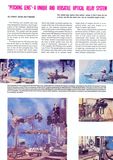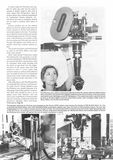This snorkel-type optical relay system, unique in that it does not use a mirror, but tilts the entire lens, has an incredible depth at field.
The Pitching Lens System was originally designed to become a second generation of the Academy Award—winning Astrovision System – an aircraft mounted periscope. This system and the system of our associate Paul Kenworthy (Type B) both use the concept of a tilting mirror to tilt the image up and down during the shooting.
The requirement for the Pitching Lens was that we be able to use Nikon or Arriflex lenses in which we would not use a mirror but, in fact, tilt the complete lens. This allowed us to shoot with much wider-angle lenses and have an optical system which was better corrected optically because of the use of the internal entrance pupil vs. the external entrance pupil, which is the case in mirror tilting systems.
In the Pitching Lens system, the lens is able to pitch 180 degrees at the end of the optical relay tube and rotate 360 degrees, and still have the image correct in the frame. Another requirement was that we have aftaster system than was the case in Astrovision. Astrovision is an F/6.3 system; the Pitching Lens system is an F/3.9. This would allow us to mount the camera and relay tube in the camera plane and allow us to achieve wider-angle shots of subject aircraft or air-to-ground shots, and also enable us to shoot at lower light levels.
After various experiments and with the technical advice of Milton Laikin, a well-known optical designer, and with the advice of end users such as director-cameraman Ron Dexter, the Pitching Lens evolved after two years of research and development. Ironically, the system has up until now never been used in an aircraft, but has been used for the filming of table-top commercials by Paul Kenworthy and his associates and one or two other director-cameramen.
[…]


